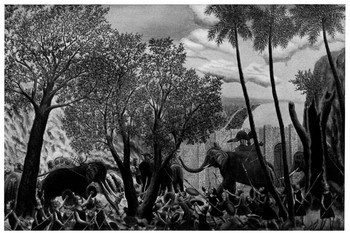Carthage's Great Victory over Rome at Cannae
 It was a small town, really, of no particular importance in its own right. It was a major source of grain, however, and it had up to that time supplied much of the Roman armies. Now, Hannibal took it for his own, town, granary, and all. Rome must respond, he thought, and respond Rome did. The response was immediate and determined. Sources differ on exactly how many Roman soldiers descended on the Carthaginian position at Cannae. Every source agrees that it was at least 50,000. Some say that the figure was higher than 60,000. Whatever the final number, it was more than Hannibal had at his disposal. He had "only" 50,000, of which 10,000 were cavalry.
It was a small town, really, of no particular importance in its own right. It was a major source of grain, however, and it had up to that time supplied much of the Roman armies. Now, Hannibal took it for his own, town, granary, and all. Rome must respond, he thought, and respond Rome did. The response was immediate and determined. Sources differ on exactly how many Roman soldiers descended on the Carthaginian position at Cannae. Every source agrees that it was at least 50,000. Some say that the figure was higher than 60,000. Whatever the final number, it was more than Hannibal had at his disposal. He had "only" 50,000, of which 10,000 were cavalry.
So here was Hannibal, outnumbered again, and pinned down by a larger Roman force. He could probably have escaped into the night, as he had been doing for several years, moving on to the next encampment in hopes of finding allies willing to throw off the Roman yoke in favor of a new day. But he determined to fight. His determination was rewarded, as was his military genius, yet again.
 On the day of the battle, Hannibal set up his cavalry on both flanks of the main army, the infantry. He knew that he was outmanned, and he wasn't sure just how effective the cavalry would be against such a well-trained Roman force. This was no Trebia River or Lake Trasimene, where the terrain could be his ally. The place at which the battle took place was mainly flat land, which was an advantage for Carthage's superior numbers in cavalry but not so much advantage as had been enjoyed before. Nonetheless, Hannibal had a plan. He had also experience on his hand: By this time, the men he had fighting for him were well experienced in battle; the Roman armies that marched on his position at Cannae, on the other hand, were riddled with brand new soldiers, for some of whom this was their first experience in real live combat.
On the day of the battle, Hannibal set up his cavalry on both flanks of the main army, the infantry. He knew that he was outmanned, and he wasn't sure just how effective the cavalry would be against such a well-trained Roman force. This was no Trebia River or Lake Trasimene, where the terrain could be his ally. The place at which the battle took place was mainly flat land, which was an advantage for Carthage's superior numbers in cavalry but not so much advantage as had been enjoyed before. Nonetheless, Hannibal had a plan. He had also experience on his hand: By this time, the men he had fighting for him were well experienced in battle; the Roman armies that marched on his position at Cannae, on the other hand, were riddled with brand new soldiers, for some of whom this was their first experience in real live combat.
The battle began simply, with both armies getting completely set up and ready to fight before any engagements took place. The sheer number of men in total and especially on the Roman side meant that the fighting didn't start until nearly midday. By this time, the Sun was high in the cloudless sky and shining right in the eyes of the advancing Romans, who were also advancing into a howling wind that was whipping up dust into the eyes of all who moved toward the Carthaginian lines. The armies moved toward each other, with the Carthaginian forces forming a strangely shaped formation that seemed to bow out in the center, as if inviting attack. Attack the Romans did, thrusting right toward the center of the Carthaginian line, while cavalry forces met on either flank. The Carthaginians steadily gave up ground, collapsing their center in the wake of the Roman assault. The Carthaginian cavalry, meanwhile, was having a field day with the less-experienced Roman horsemen and soon had command of the flanks, sending the enemy cavalry galloping in retreat, not to be a factor again. The more the Romans pushed forward, the more ground they gained, too much it seemed. The Carthaginian cavalry, meanwhile, moved to harass the Roman line from behind. As suddenly as a door swinging shut, the Romans were surrounded. The Carthaginian infantry gave way ... in favor of the vastly experienced heavy infantry and crack troops, the heart of Hannibal's army, who counterattacked with a savage fierceness. The Carthaginian cavalry now moved in from either flank and from behind. The Roman troops were caught between four pincers of an impossibly strong vise, and they had nowhere to go. Faced with certain death on all sides, the Romans fought bravely but ultimately went down in defeat. Such was the savagery of the Carthaginian hatred for Rome by this time that not a man was left standing that hadn't already fled the field.